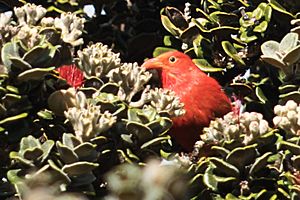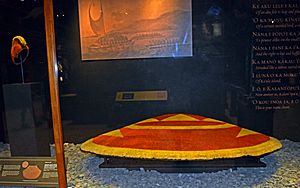ʻAhu ʻula facts for kids

The ʻAhu ʻula (which means feather cloak in the Hawaiian language) and the mahiole (a feather helmet) were very important symbols. They showed the highest rank of the powerful chiefs in ancient Hawaii. These beautiful cloaks and capes not only protected people physically but were also believed to offer spiritual protection.
Today, there are over 160 of these traditional Hawaiian clothes in museums around the world. At least six of them were collected during the famous trips of Captain Cook. These special cloaks are made from a woven net decorated with many bird feathers. They are amazing examples of featherwork art. One of these cloaks even appeared in a painting about Captain Cook's death by Johann Zoffany.
Contents
How Were These Feather Cloaks Made?
The ʻAhu ʻula cloaks were created using a special woven net. This net was then covered with feathers from local birds. The plant used to make the netting is called Touchardia latifolia, which is a type of nettle.
Getting the Feathers
Different types of feathers were used to create the vibrant colors. Black and yellow feathers came from four kinds of birds called ʻōʻōs. Sadly, all these birds became extinct by 1987, probably due to sickness. Black feathers also came from two types of mamo birds, which are also now extinct.
The bright red feathers came from the ʻIʻiwi and the ʻApapane birds. You can still find both of these bird species in Hawaii, but their numbers are much smaller. Even though birds were used for their feathers, it's thought that this didn't harm the bird populations too much. Special bird catchers would carefully catch the birds, take a few feathers, and then let the birds go free.
Hundreds of thousands of feathers were needed for each cloak! Small groups of feathers were gathered and carefully tied into the netting. These bundles were placed very close together to make a smooth, even surface on the cloak.
A Special Gift to Captain Cook
When the British explorer James Cook visited Hawaiʻi on January 26, 1778, he met a powerful chief named Kalaniʻōpuʻu. At the end of their meeting, Chief Kalaniʻōpuʻu placed the feather helmet (mahiole) and cloak (ʻahu ʻula) he was wearing onto Captain Cook. Kalaniʻōpuʻu also offered several other cloaks, four large pigs, and other food items to Cook.
Many items from Cook's voyages, including this helmet and cloak, later became part of Sir Ashton Lever's collection. He showed them in his museum, the Holophusikon. It was at this museum that artist Johann Zoffany borrowed Cook's mahiole and cloak in the 1790s. He then included them in his famous painting, The Death of Captain James Cook.
Sir Ashton Lever later lost all his money. His collection was sold off in a public lottery. The collection was bought by James Parkinson, who continued to display it in London. He eventually sold the collection in 1806 through many separate sales. The mahiole and cloak were bought by another collector, William Bullock. He showed them in his own museum until 1819, when his collection was sold again.
The mahiole and cloak were then purchased by Charles Winn. They stayed with his family until 1912. That year, Charles Winn's grandson, Rowland Winn, 2nd Baron St Oswald, gave them to New Zealand. Today, these important items are kept at the Museum of New Zealand Te Papa Tongarewa.
Captain Cook's mahiole and cloak were even featured in episode 52 of the TV series Tales from Te Papa.
Where Can You See Them Today?
Many museums around the world have ʻAhu ʻula and mahiole on display.
The Bernice P. Bishop Museum in Honolulu has a 200-year-old mahiole and a matching cloak. This bright red and yellow cloak was given to the king of Kauaʻi, Kaumualiʻi, in 1810. This happened when he agreed to rule under Kamehameha I, which united all the Hawaiian islands into the Kingdom of Hawaii.
The de Young Museum in San Francisco showed several of these cloaks in a special exhibit in 2015.
The British Museum has three of these cloaks in its collection.
The National Museums of Scotland display a feather cloak that was given in 1824. It was a gift from King Kamehameha II of Hawaii to Frederich Gerald Byng. This was to thank him for his help in London.
The Museum of New Zealand Te Papa Tongarewa has three ʻahu ʻula cloaks. All of them were gifts from Lord St Oswald in 1912. The Museum of New Zealand Te Papa Tongarewa believes that one of these cloaks was the very one placed on Captain James Cook by the Hawaiian chief Kalani’ōpu’u.
Auckland Museum also added a cloak to its collection in 1948.
Images for kids
-
A 200-year-old mahiole and ʻahuʻula at the Bishop Museum, in Oahu, Hawaii
-
An ʻAhu ʻula linked to Hawaiian monarch Kalaniʻōpuʻu, on display at the de Young Museum in San Francisco





